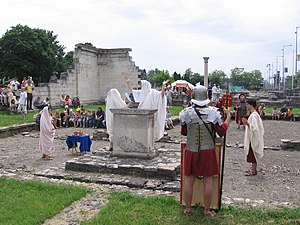
Back نظرية الإستعادة Arabic Reconstruccionisme pagà Catalan Rekonstrukcionismus Czech Reconstruccionismo pagano Spanish بازسازیگرایی چندخداپرستی Persian Reconstructionnisme polythéiste French Բազմաստվածային վերականգնողականություն Armenian Fiverenana amin' ny pôliteisma Malagasy Rekonstrukcjonizm Polish Reconstrucionismo politeísta Portuguese

Polytheistic reconstructionism (or simply reconstructionism) is an approach to modern paganism first emerging in the late 1960s to early 1970s, which gathered momentum starting in the 1990s. Reconstructionism attempts to re-establish genuine polytheistic religions in the modern world through a rediscovery of the rituals, practices and contextual worldviews of pre-Christian pagan religions. This method stands in contrast with other neopagan syncretic movements like Wicca, and ecstatic/esoteric movements like Germanic mysticism or Theosophy.
While the emphasis on historical accuracy may imply historical reenactment, the difference between these two movements can be summarized as one of intent. Historical reenactment seeks historical accuracy as a goal in and of itself. On the other hand, a reconstructionist neopagan views historical accuracy as a means to the end of establishing a harmonious relationship between a belief-community and the gods.
In short, the guiding principles of the reconstructionist approach to the practice of pre-Christian religion can be broken down as follows:
- The pre-Christian pagans had a harmonious relationship to their deities.
- The rites and rituals of those pagans were an essential part of the navigation and mediation of that relationship.
- If modern-day pagans wish to re-establish a harmonious relationship with these deities, then these rituals and rites must be properly performed.
- To properly perform the rituals in the present day, modern pagans must discover how and why they were performed in the past.
The term "reconstructionist paganism" was likely coined by Isaac Bonewits in the late 1970s.[1] Bonewits has said that he is not sure whether he "got this use of the term from one or more of the other culturally focused Neopagan movements of the time, or if [he] just applied it in a novel fashion".[1]
Margot Adler later used the term "Pagan Reconstructionists" in the 1979 edition of Drawing Down the Moon to refer to neopagans who endeavour to revive or "reconstruct" an authentic pre-Christian religious practice through use of historically verifiable research in fields such as: archeology, folklore studies and anthropology.
This emphasis on reconstruction contrasts with the more syncretic, eclectic or occult approaches to neopaganism, as seen for example in Thelema or Wicca.[2]
- ^ a b Bonewits, Isaac (2006). Bonewits's Essential Guide to Druidism. New York: Kensington/Citadel. p. 131. ISBN 0-8065-2710-2.
- ^ Adler, Margot (1979). "Chapter 9: Religions from the Past—The Pagan Reconstructionists". Drawing Down the Moon: Witches, Druids, Goddess-Worshippers, and Other Pagans in America Today. Boston: Beacon Press. ISBN 0-8070-3237-9.
© MMXXIII Rich X Search. We shall prevail. All rights reserved. Rich X Search